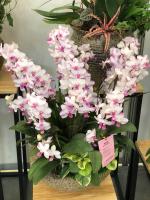What Does Mold on a Pot Plant Look Like?
As a houseplant enthusiast, it can be disheartening to find that your beloved pot plant has become infested with mold. Mold on a pot plant is a common issue and can be caused by a variety of factors, including overwatering, poor drainage, and improper ventilation. If left untreated, mold can damage the plant and even spread to other plants in your home. But how do you know if your plant has mold, and what does mold on a pot plant look like?
Identifying Mold on a Pot Plant
Mold on a pot plant can be difficult to spot at first, but some telltale signs can help you identify the problem. The most obvious sign of mold is the appearance of fuzzy, white, or greenish-black spots on the plant's leaves, stems, or soil. These spots may look like a cluster of tiny dots or may cover a larger area of the plant. If you notice a musty or unpleasant odor coming from your plant, this could also be a sign of mold.
Types of Mold on a Pot Plant
There are many different types of mold that can grow on pot plants, each with its own unique appearance and characteristics. One common type of mold is powdery mildew, which appears as a white or grayish powder on the plant's leaves, stems, and flowers. Another type of mold is black mold, which appears as a greenish-black or dark brown discoloration on the plant's leaves and stems. Other types of mold include gray mold, downy mildew, and botrytis, which are all characterized by their grayish or brownish coloration.
Causes of Mold on a Pot Plant
Mold on a pot plant can be caused by a variety of environmental factors. Overwatering is a common cause of mold, as excess moisture can create a damp environment that is ideal for mold growth. Poor drainage, lack of sunlight, and high humidity levels can also contribute to mold growth on pot plants. In addition, poor air circulation and overcrowding of plants can create a favorable environment for mold growth. To prevent mold from growing on your pot plants, it's important to maintain proper moisture levels, provide adequate drainage, and ensure proper air circulation and ventilation.
Preventing Mold on a Pot Plant
Preventing mold on a pot plant is much easier than treating an existing mold problem. To prevent mold, it's important to keep your plants healthy and well-maintained. Make sure your plants are not getting too much or too little water, and ensure they have proper drainage. Avoid over-fertilizing your plants, as excess nutrients can lead to mold growth. In addition, provide good air circulation by opening windows or using a fan, and avoid overcrowding your plants. Regularly inspect your plants for any signs of mold or other problems, and promptly address any issues that arise. By following these simple steps, you can help prevent mold from growing on your pot plants and keep them healthy and vibrant for years to come.
Treating Mold on a Pot Plant
If you do find mold on your pot plants, it's important to act quickly to prevent it from spreading. The first step is to isolate the infected plant and remove any moldy leaves or stems. Avoid touching the mold with your bare hands, as this can spread the spores to other plants or surfaces. Instead, wear gloves and use a damp cloth or paper towel to gently wipe away the mold. Once you've removed the mold, treat the plant with a fungicide spray, which can help kill any remaining spores and prevent future mold growth. If the mold problem is severe, you may need to repot the plant in fresh soil and dispose of the old soil to prevent recontamination. Remember to regularly inspect your plants for any signs of mold or other problems, and promptly address any issues that arise.
In conclusion, mold on a pot plant can be a frustrating and potentially damaging problem, but it can be prevented and treated with proper care and maintenance. By maintaining proper moisture levels, providing adequate drainage, ensuring good air circulation, and promptly addressing any problems that arise, you can help prevent mold from growing on your pot plants and keep them healthy and vibrant for years to come.

 how many times do yo...
how many times do yo... how many planted tre...
how many planted tre... how many pine trees ...
how many pine trees ... how many pecan trees...
how many pecan trees... how many plants comp...
how many plants comp... how many plants can ...
how many plants can ... how many plants and ...
how many plants and ... how many pepper plan...
how many pepper plan...
































